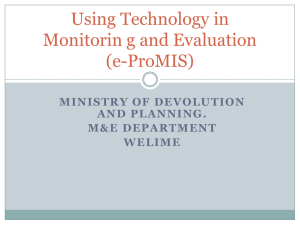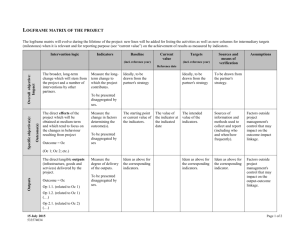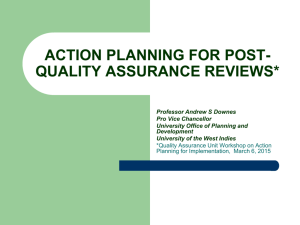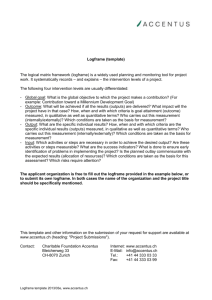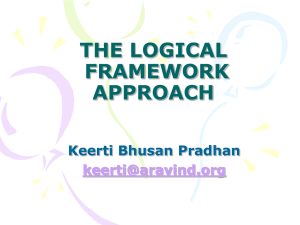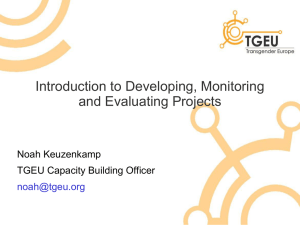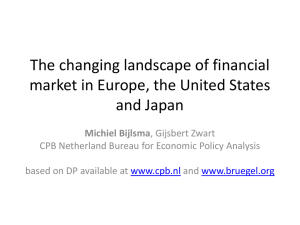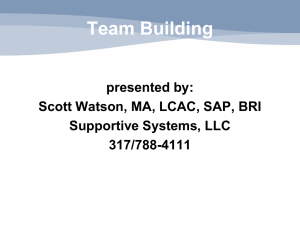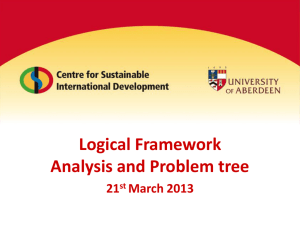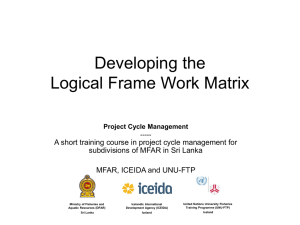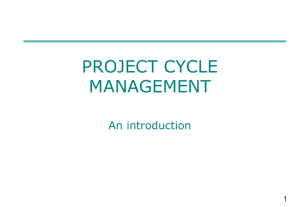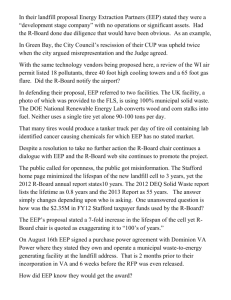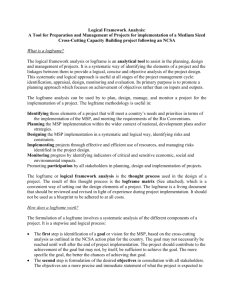project concept formulation
advertisement
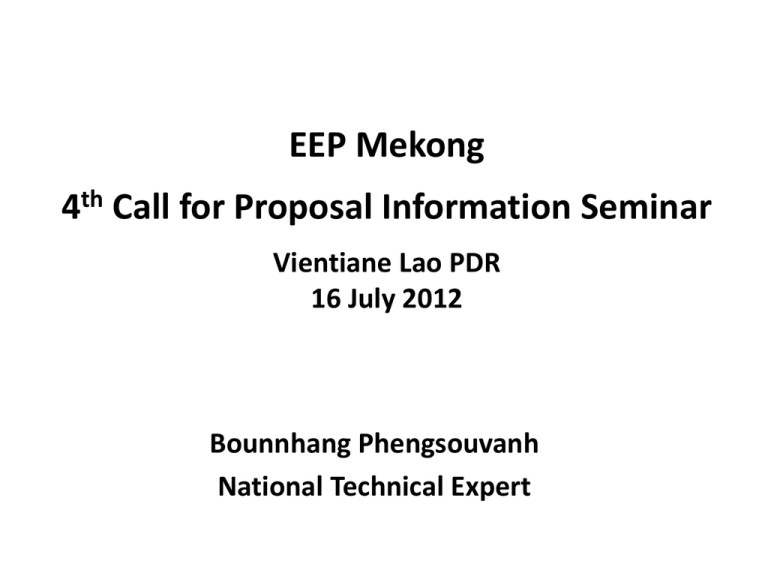
EEP Mekong 4th Call for Proposal Information Seminar Vientiane Lao PDR 16 July 2012 Bounnhang Phengsouvanh National Technical Expert Presentation Lay out • The objectives Purposes • Concept Note and Development Approach • Logical Frame Work and Inter-linkage Development 1: The Objectives and Purposes The Overall Objectives • The Participants are able to understand EEP’s project concept note design, Full Project Proposal Formulation. Purposes: • To support and improve quality of new “Project Concept Note writing” and “Full Project Proposal formulation”. 2:Concept Note Idea and Development Approach • Project Concept note Understanding • “UNDERSTANDING” is crucial to everything in Project Concept note formulation. • We must be able to “understand” and “explain”. – The 1 minute explanation: 10 km. view. – The 5 minute explanation: 1 km. view. – The half hour explanation: 10 to 100 metres. • To do this, we must be able to “visualise”: – we need a 4 D model in our heads. – We should be able to jump in and out of this. 10 km view (concept) 1 km view( full) 10 to 100 metres view (Implementation) PROJECT CONCEPT FORMULATION • The “project concept” is essentially the rationale and basic “business” idea of the project. • There is no “magic formula” for developing the basic concept. This draws on some of the skills covered earlier in this workshop but may also include systematic analysis as well as inspirational brainstorming of – problems to be solved to bring benefit, and – Opportunities to develop something with benefits: often based on new technology or other innovations. • This is a creative process which is generally flexible and iterative (repeated in cycles). PROJECT CONCEPT FORMULATION (Continue) Tools” may help to test and improve the basic idea and design: • Problem and situation analysis: problem trees. • Stakeholder analysis. • Visioning, scenario planning. • Cost-benefit analysis. • Logical framework analysis. PROJECT CONCEPT FORMULATION (continue) A “mechanism-based” approach: can help to understand how the proposed project should work and improve design. 1. The Benefit: What is the benefit and how is it generated / produced? How does it contribute to EEP objectives? 2. Distribution of the benefit: Who receives the benefit: individuals, groups, the community, the sector, men or women, rural or urban people, poor or rich, etc? 3. “Sustainability”: What benefits / outputs / activities should be sustained at the end of the project, and how will they be sustained? 4. “Replicability” (also known as “scaling-up” or “spread”): How can the benefits / outputs / activities be spread (what is the mechanism) and how easy would this be?. 5. “Implementability”: Is the project understandable? Do the proponents have the capacity? Will it work? 3. LOGICAL FRAMEWORK APPROACH (LFA) • One way to describe projects is as a series of connected objectives. • This “connection” follows the “cause and effect” logic. • This provides a “logic model” of what should happen. The 4 levels of the “Logframe”: • “Activities”: the things we do, or actions implemented. • “Outputs” (also called “Results”): the products and services of activities: i.e. the things produced. These are the “deliverables” of the project • “Purpose” (also called “immediate objective”): the combined effects or outcomes of the outputs to be achieved by the end of the project. • “Overall objective” (also called “goal”): the overall long term effects or outcomes to which the project contributes. Key points: • Understanding the change process is the key to success. • Construct the internal logic model diagram which clearly summarises the overall change process as “activities” “outputs” “purpose” “overall objective”. • Develop objective and practical indicators which work (i.e. assess the change) from the sound understanding of the change processes in the internal logic model. INDICATORS • The internal logic model diagram gives us a “Results Chain”. • We need to achieve each box or “result”. • To know how well we are progressing in achieving each result, we need “indicators” (for each box). • Develop “indicators” is the second major task in development of the full logframe. Indicators continue… Definition of an indicator: • “a quantitative or qualitative variable that allows stakeholders to verify the changes produced by a development intervention relative to what was planned”. • A “key indicator” is an indicator for a logframe output, purpose or overall objective. Purpose of an indicator: • To show if and how much change has occurred: – may not necessarily explain the change. Completion of the “Logframe Table” and the “key indicator definition table” • A complete Logframe is usually presented in a table or matrix format with: – Project Description: the hierarchy of objectives. – Indicators: “objectively verifiable indicators”. – Source of verification: where the date for the indicators will come from. – Important Risks / Assumptions: external factors which could affect the success of the project: the “external logic”. Example of internal logic model: Use of the logframe: As ideas take shape, the log-frame should be constructed in stages as outlined earlier: • Develop the internal logic model using the diagram to visualise this. • Once the internal logic has been developed,, develop the main key indicators and draft targets, identify the most important assumptions / risks and compile the draft log frame table. Use this to help, prepare the “Project Concept / Proposal Form” for submission to EEP. Exercises –as Example No 1 2 3 3 4 5 6 7 8 9 10 Expression ( sentence) Training of village community organisers. Community based organisation established and operational. Micro-hydro stations fully and sustainably operational . Biogas entrepreneurs trained. Business plan developed. Greenhouse gases reduced. Meetings with local businesses. Awareness raising campaigns. Improved environment. Improved income and living standards. Survey and selection of micro-hydro site. Objective/Out put/Activities Activity Output? Objectives/purp Activity/output /output Objectives Activity Activity OveralObjective Overal Objective Activity Example: Continue Objective Purpose: Pilot farm biogas digester construction and financing model developed and proved, with associated benefits. Output 2: Biogas digester construction teams trained, organised and operational. Existing Indicators Within 18 months 10 digesters will be in operation. ± 100 jobs will have been created. Business model will be in place for roll-out of the technology. Construction can and will continue after finalizing the 10 farms under this EEP project based on the business model framework developed within this project. Comments and improved inds OK: need to define “operation”. In total the project aims at training of 30 people on several levels, and construction teams are lined up Expected positions are a technician at the provincial and district level, mason supervisors, mason teams, unskilled labourers (for construction) and farmers. OK. OK. NO, Drop this. Not well defined and applies more to the overall objective. Notes: Indicators cover the main elements of the purpose. No of M/F trained for the different levels: labourers, masons, supervisors. No of teams established. Notes: Need to word as Indicators. Thank You
